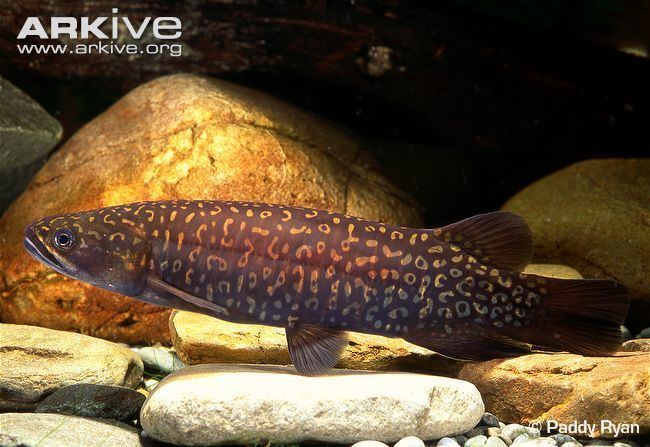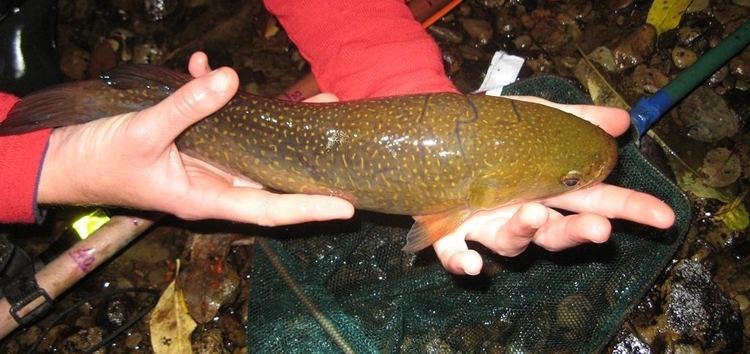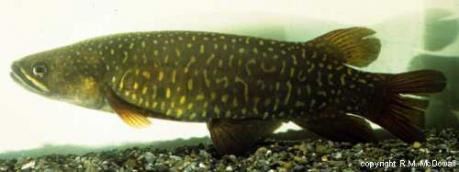Kingdom Animalia Subfamily Galaxiinae Scientific name Galaxias argenteus Higher classification Galaxias Order Osmeriformes | Family Galaxiidae Genus Galaxias Phylum Chordata Rank Species | |
 | ||
Similar Banded kokopu, Shortjaw kokopu, Climbing galaxias, Galaxias, Galaxiidae | ||
Giant kokopu
The giant kokopu (Galaxias argenteus) is a threatened species of ray-finned fish in the genus Galaxias, found only in New Zealand. It can reach up to 58 cm (23 in) in length and 2.7 kg (6.0 lb) in weight, making it the largest species in the family Galaxiidae. It is a mainly lowland species, commonly found in slow-flowing streams, wetlands, lakes, and lagoons. Most populations have an amphidromous life cycle, with larvae going to sea soon after hatching and returning about four months later as small juveniles, 4.5–5 cm (1.8–2.0 in). Juvenile giant kokopu form a small part of the annual whitebait catch.
Contents

The first scientifically described species in the family, the giant kokopu was initially placed in the genus Esox (pikes) by Johann Friedrich Gmelin in 1789. Recognising that it was not a pike, the genus name Galaxias was coined by Georges Cuvier in 1816 as a reference to its somewhat star-like (galaxy) pattern. The genus was later expanded to include numerous other species, most of which lack this pattern.

Niwa fish tagging giant kokopu
Description

The giant kokopu commonly grows to 30–40 cm (12–16 in) in total length. Larger individuals are uncommon, but it can reach up to 58 cm (23 in) in length and 2.7 kg (6.0 lb) in weight, making it the largest species of galaxiid. Like all galaxiids, this fish lacks scales and has a thick, leathery skin covered with mucus. The body is very broad, appearing round or square in cross-section, with strong, fleshy fins. The mouth is very large. Giant kokopu are typically olive brown, varying from near-black to pale olive. In adults the body is patterned with pale yellow spots, crescents and lines, markings becoming smaller and more profuse as the fish ages; the patterning begins in juveniles with sparse vertical bars and spots along the lateral line. As the fish grows these markings lengthen and then fade out, while the adult markings fade in. Small giant kokopu may be confused with small banded kokopu (Galaxias fasciatus), but giant kokopu lack a silver mark behind the gills, and their markings never fork or fade out at the top and bottom.
Behaviour and habitat

Adult giant kokopu are found in freshwater, primarily near the coast, and their young enter freshwater in the spring after spending 4—6 months in the sea. It has never actually been observed spawning in the wild, but it occurs during the autumn/winter and the eggs (first discovered in 2013) are placed among vegetation along the banks. The species has a relatively high fecundity, with each female producing several thousand eggs. As typical of amphidromous galaxiids from New Zealand, the eggs develop in semi-dry conditions on land for a few weeks and are then flooded by rising water. The best hatch rates for the eggs are in freshwater at a temperature of about 10 °C (50 °F). Although primarily amphidromous, some populations exist permanently in land-locked stream systems, showing that it can complete its life-cycle in freshwater. Maturity is reached when 2—3 years old. The oldest known individual, which was 40 cm (16 in) long and weighed 1.05 kg (2.3 lb), was estimated to be 21—27 years old based on its otolith. Adults prefer slow-flowing waters in lowland streams or pools. They usually use cover such as overhanging vegetation, logs, undercut banks, or debris to lurk, awaiting passing prey. They prefer water temperatures between 11 and 15 °C (52–59 °F), but can also live outside this range. Their rarity north of Auckland is probably related to temperature. Their diet includes aquatic and terrestrial insects, freshwater crayfish (Paranephrops spp.), spiders and occasionally other fish. They are generally nocturnal and slow-moving.
Status

In 2014, the New Zealand Department of Conservation classified the giant kokopu as "At Risk: Declining" under criterion "B(1/1) - 20,000–100,000 mature individuals, predicted decline 10–50%". The giant kokopu has been rated as "Vulnerable" by the IUCN since 1996. Primary reasons for their decline include ongoing drainage of wetlands, drain clearance, and land-use changes, particularly the expansion and intensification of dairy farming. Other threats are loss of riparian vegetation and introduced salmonids (trout).

Giant kokopu have been successfully bred in captivity. The species is highly prized as a traditional food and is considered to have potential in aquaculture.
